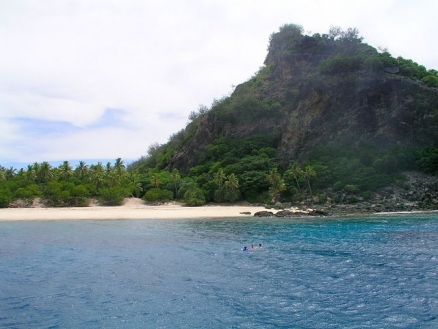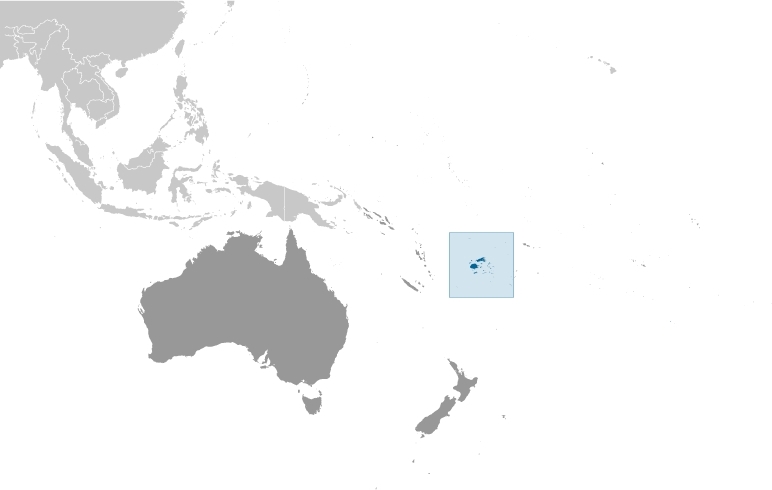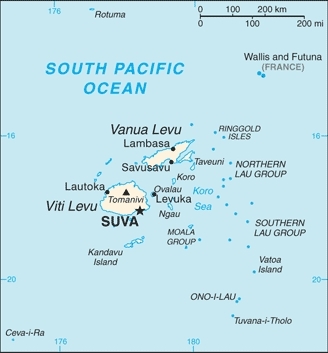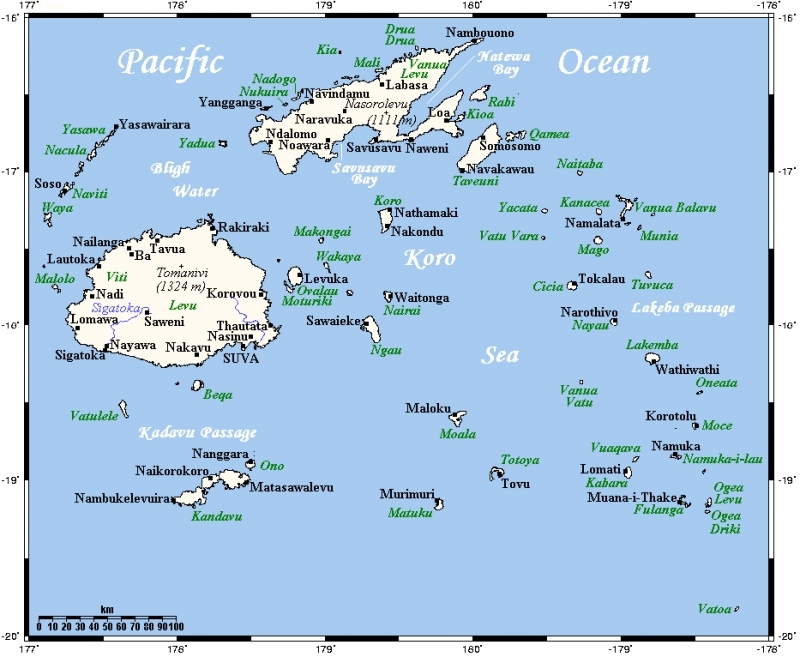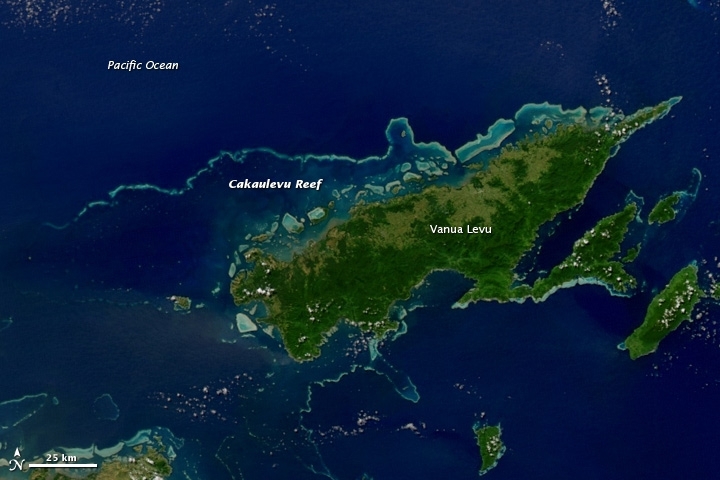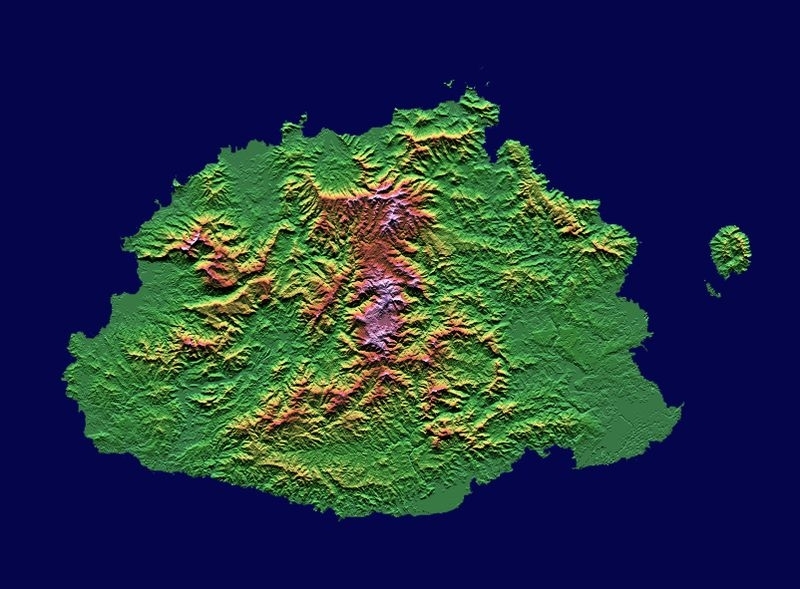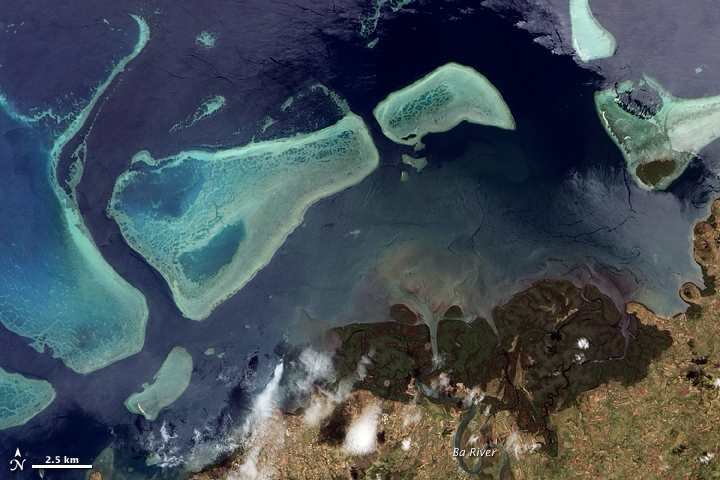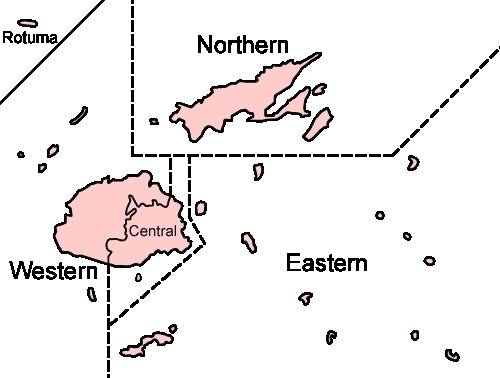Fiji
Countries and Regions of the World Collection  Fiji is an island group whicch includes 332 islands (approximately 110 are inhabited with just under 900,000 people) in the South Pacific Ocean, about two-thirds of the way from Hawaii to New Zealand.
Fiji is an island group whicch includes 332 islands (approximately 110 are inhabited with just under 900,000 people) in the South Pacific Ocean, about two-thirds of the way from Hawaii to New Zealand.
Its major environmental issues include: deforestation and soil erosion.
Fiji is susceptible to cyclonic storms whcih can occur from November to January.
Fiji became independent in 1970 after nearly a century as a British colony.
Democratic rule was interrupted by two military coups in 1987 caused by concern over a government perceived as dominated by the Indian community (descendants of contract laborers brought to the islands by the British in the 19th century).
The coups and a 1990 constitution that cemented native Melanesian control of Fiji led to heavy Indian emigration. The population loss resulted in economic difficulties, but ensured that Melanesians became the majority.
A new constitution enacted in 1997 was more equitable. Free and peaceful elections in 1999 resulted in a government led by an Indo-Fijian, but a civilian-led coup in May 2000 ushered in a prolonged period of political turmoil.
Parliamentary elections held in August 2001 provided Fiji with a democratically elected government led by Prime Minister Laisenia Qarase.
Re-elected in May 2006, Qarase was ousted in a December 2006 military coup led by Commodore Voreqe Bainimarama, who initially appointed himself acting president but in January 2007 became interim prime minister.
Since taking power Bainimarama has neutralized his opponents, crippled Fiji's democratic institutions, and refused to hold elections.
Contents
Geography
Fiji is comprised of a group of volcanic islands in the South Pacific lying about 4,450 km. (2,775 mi.) southwest of Honolulu and 1,770 km. (1,100 mi.) north of New Zealand. Its 322 islands vary dramatically in size. The largest islands are Viti Levu, about the size of the "Big Island" of Hawaii, and where the capital and 70% of the population are located, and Vanua Levu. Just over 100 of the smaller islands are inhabited. The larger islands contain mountains as high as 1,200 meters (4,000 ft.) rising abruptly from the shore.
Heavy rains--up to 304 cm. (120 in.) annually--fall on the windward (southeastern) sides of the islands, covering these sections with dense tropical forest. Lowlands on the western portions of each of the main islands are sheltered by the mountains and have a well-marked dry season favorable to crops such as sugarcane.
Location: Oceania, island group in the South Pacific Ocean, about two-thirds of the way from Hawaii to New Zealand
Geographic Coordinates: 18 00 S, 175 00 E
Area: 18,274 sq km. The islands of Viti Levu and Vanua Levu occupy 78% of the land area in Fiji.
Coastline: 1,129 km
Maritime Claims:
measured from claimed archipelagic straight baselines
territorial sea: 12 nm
exclusive economic zone: 200 nm
continental shelf: 200 m depth or to the depth of exploitation; rectilinear shelf claim added
Natural Hazards: cyclonic storms can occur from November to January
Terrain: mostly mountains of volcanic origin. The highest point is Tomanivi 1,324 m
Climate: tropical marine; only slight seasonal temperature variation
Source: Wikimedia Commons
Ecology and Biodiversity
Most islands are the remnants of once active volcanoes sitting on a piece of the Pacific Plate drifting slowly southeast through an extensive zone of fracturing, volcanism, and shearing resulting from the subduction of the Pacific Plate under the Australian Plate. The oldest terrestrial areas have probably been exposed for 5-20 million years but the youngest island, Taveuni, last erupted 2000 years ago. Most soils are derived from volcanic material, but some are comprised of uplifted marine reefs and sediments and rivers on older islands have formed alluvial plains of sedimentary soils.
The Fiji tropical moist forests ecregion covers much of Fiji and the Wallis and Futuna Islands contain the richest natural communities of all the oceanic islands of the Pacific (not including New Caledonia). Their relative isolation, large size and complex topography, and unusual biogeographic history have all contributed to the archipelagos' highly endemic biota. Over half of the vascular plant species are endemic, with many single-island and single-site endemics. Twenty-five birds occur only in Fiji (plus one on Rotuma) and most of the reptiles, amphibians, bats, and invertebrates are unique to the islands. The biota is derived from ancient Gondwanaland elements, including one of the world's most primitive plant families endemic to the islands, and taxa that have dispersed across the ocean.
Fiji tropical dry forests - Tropical dry forests are limited to relatively large islands in the tropical South Pacific where mountains create rain shadows. The Fijian and New Caledonian dry forests are the largest dry forests of the region, both support a large number of endemic species and both are critically endangered with only remnants remaining. Long, dry winters are typical in the northwest of Fiji’s large islands and have produced extensive dry forest communities unique in the Pacific. Unfortunately, this forest which once covered 7557 km2 is now found on less than 100 km2 and is probably one of the most endangered habitats in the tropical Pacific. The orientation of Fiji’s mountains and the constancy of southeast trade winds results in a rain shadow to the northwest of high mountain areas. Tropical dry forest is found in these areas on the larger islands and on island groups in the lee of larger islands.
See also: Biological diversity in Polynesia-Micronesia
Cakaulevu Reef
Surrounded by the warm waters of the South Pacific, the Fiji Islands are often cloaked in clouds when the Aqua or Terra satellites fly over. But July 21, 2011, offered up a perfectly cloud-free view. This image from the Moderate Resolution Imaging Spectroradiometer (MODIS) on Aqua shows Fiji’s second-largest island, Vanua Levu, and the Cakaulevu Reef that shelters the island’s northern shore. Source: NASA image courtesy Norman Kuring, NASA Ocean Color Team. Caption by Holli Riebeek.
Also called the Great Sea Reef, Cakaulevu shines turquoise through clear, shallow waters. It is the third longest continuous barrier reef in the world, behind the Great Barrier Reef in Australia and the Mesoamerica Reef off Central America. When combined with the nearby Pascoe Reef, Cakaulevu Reef is about 200 kilometers (120 miles) long. On its own, the Cakaulevu Reef covers 202,700 square kilometers (77,200 square miles).
The first systematic survey of the reef (in 2004) revealed a diverse marine population, including unique mangrove ecosystems and endemic fish. Twelve threatened species live within the reef: 10 fish species, the green turtle, and the spinner dolphin.
All of this marine life has traditionally supported the native population, and currently some 70,000 people depend on the reef. After seeing fish populations decline in recent decades, local leaders created a series of marine protected areas in 2005 where fishing is prohibited. Traditional customs used to manage the reef for hundreds of years permit leaders to set aside portions of the qoliqoli, or traditional fishing ground. Where the ban has been enforced, fish populations are rebounding and spilling over into areas where fishing is permitted.
From space, none of this bounty is visible. Instead, the beauty comes from the vivid shades of blue and green coral creates when viewed through water.
People and Society
Population: 890,057 (July 2012 est.)
Most of Fiji's population lives on Viti Levu's coasts, either in Suva or in smaller urban centers. The interior of Viti Levu is sparsely populated due to its rough terrain.
Indigenous Fijians are a mixture of Polynesian and Melanesian, resulting from the original migrations to the South Pacific many centuries ago. The Indo-Fijian population grew rapidly from the 60,000 indentured laborers brought from India between 1879 and 1916 to work in the sugarcane fields. Thousands more Indians migrated voluntarily in the 1920s and 1930s and formed the core of Fiji's business class. Native Fijians live throughout the country, while Indo-Fijians reside primarily near the urban centers and in the cane-producing areas of the two main islands. Nearly all of indigenous Fijians are Christian; more than three-quarters are Methodist. Approximately 80% of Indo-Fijians are Hindu, 15% are Muslim, and around 6% are Christian.
Some Indo-Fijians have been displaced by the expiration of land leases in cane-producing areas and have moved into urban centers in pursuit of jobs. Similarly, a number of indigenous Fijians have moved into urban areas, especially Suva, in search of a better life. Meanwhile, the Indo-Fijian population has declined due to emigration and a declining birth rate. Indo-Fijians currently constitute 37% of the total population, although they were the largest ethnic group from the 1940s until the late 1980s. Indo-Fijians continue to dominate the professions and commerce, while ethnic Fijians dominate government and the military.
Ethnic groups: Fijian 57.3% (predominantly Melanesian with a Polynesian admixture), Indian 37.6%, Rotuman 1.2%, other 3.9% (European, other Pacific Islanders, Chinese) (2007 census)
Age Structure:
0-14 years: 28.9% (male 130,409/female 124,870)
15-64 years: 65.9% (male 297,071/female 284,643)
65 years and over: 5.2% (male 21,187/female 24,945) (2011 est.)
Population Growth Rate: 0.766% (2012 est.)
Birthrate: 20.7 births/1,000 population (2012 est.)
Death Rate: 5.93 deaths/1,000 population (July 2012 est.)
Net Migration Rate: -7.11 migrant(s)/1,000 population (2012 est.)
Life Expectancy at Birth: 71.59 years
male: 69 years
female: 74.32 years (2012 est.)
Total Fertility Rate: 2.58 children born/woman (2012 est.)
Languages: English (official), Fijian (official), Hindustani
Literacy: (age 15 and over can read and write): 93.7% (2003 est.)
Urbanization: 52% of total population (2010) growing at an annual rate of change of 1.3% (2010-15 est.)
Viti Levu. Source: NASA
History
Melanesian and Polynesian peoples settled the Fijian islands some 3,500 years ago. European traders and missionaries arrived in the first half of the 19th century, and the resulting disruption led to increasingly serious wars among the native Fijian confederacies. One Ratu (chief), Cakobau, gained limited control over the western islands by the 1850s, but the continuing unrest led him and a convention of chiefs to cede Fiji unconditionally to the British in 1874.
The pattern of colonialism in Fiji during the following century was similar to that in many other British possessions: the pacification of the countryside, the spread of plantation agriculture, and the introduction of Indian indentured labor. Many traditional institutions, including the system of communal land ownership, were maintained.
Fiji soldiers fought alongside the Allies in the Second World War, gaining a fine reputation in the tough Solomon Islands campaign. The United States and other Allied countries maintained military installations in Fiji during the war, but Fiji itself never came under attack.
In April 1970, a constitutional conference in London agreed that Fiji should become a fully sovereign and independent nation within the Commonwealth. Fiji became independent on October 10, 1970. Post-independence politics came to be dominated by the Alliance Party of Ratu Sir Kamisese Mara. The Indian-led opposition won a majority of House seats in 1977, but failed to form a government out of concern that indigenous Fijians would not accept Indo-Fijian leadership. In April 1987, a coalition led by Dr. Timoci Bavadra, an ethnic Fijian supported by the Indo-Fijian community, won the general election and formed Fiji's first majority Indian government, with Dr. Bavadra serving as Prime Minister. Less than a month later, Dr. Bavadra was forcibly removed from power during a military coup led by Lt. Col. Sitiveni Rabuka on May 14, 1987.
After a period of deadlocked negotiations involving the Governor-General, who had denounced the coup, Rabuka staged a second coup on September 25, 1987. The military government revoked the 1970 constitution and declared Fiji a republic on October 10. This action, coupled with protests by the Government of India, led to Fiji's expulsion from the Commonwealth of Nations and official non-recognition of the Rabuka regime from foreign governments, including Australia and New Zealand. On December 6, 1987, Rabuka resigned as head of state and Governor-General Ratu Sir Penaia Ganilau was appointed the first President of the Fijian Republic. The interim government that governed Fiji from December 1987-1992 was led by former Prime Minister Mara who was reappointed interim Prime Minister, and Rabuka became Minister of Home Affairs.
The new government drafted a new constitution, effective July 1990. Under its terms, majorities were reserved for ethnic Fijians in both houses of the legislature. Previously, in 1989, the government had released statistical information showing that for the first time since 1946, ethnic Fijians were a majority of the population. More than 12,000 Indo-Fijians and other minorities had left the country in the 2 years following the 1987 coups. After resigning from the military, Rabuka became prime minister in 1993 after elections under the new constitution.
Tensions simmered in 1995-96 over the renewal of land leases and political maneuvering surrounding the mandated 5-year review of the 1990 constitution. A Constitutional Review Commission recommended a new constitution that expanded the size of the legislature, lowered the proportion of seats reserved by ethnic group, gave to the unelected Council of Chiefs authority to appoint the president and vice president, and opened the position of prime minister to all races. Ethnic Fijians and Indo-Fijians were allocated communal seats proportional to their numbers in the population at the time. Twenty-five seats were "open" to all. Prime Minister Rabuka and President Mara supported the proposal, while the nationalist indigenous Fijian parties opposed it. The constitution amendment act was unanimously approved by parliamentarians in July 1997. The new constitution mandated the formation of a multi-party cabinet (each party with 10% of members of Parliament was entitled to nominate a cabinet minister). Fiji was readmitted to the Commonwealth.
The first legislative elections held under the new constitution took place in May 1999. Rabuka's coalition was defeated by the Fiji Labor Party (FLP), which formed a coalition, led by Mahendra Chaudhry, with two small Fijian parties. Chaudhry became Fiji's first Indo-Fijian prime minister. One year later, in May 2000, Chaudhry and most other members of Parliament were taken hostage in the House of Representatives by gunmen led by ethnic Fijian nationalist George Speight. The standoff dragged on for 8 weeks--during which time Chaudhry was removed from office by then-president Mara due to his inability to govern while a hostage. The Republic of Fiji military forces abrogated the constitution, convinced President Mara to resign, and brokered a negotiated end to the situation. Speight was later arrested when he violated the settlement's terms. In February 2002, Speight was convicted of treason and is currently serving a life sentence.
In July 2000, the military commander Voreqe “Frank” Bainimarama and the Great Council of Chiefs appointed former banker Laisenia Qarase interim Prime Minister and head of the interim civilian administration. The Vice President, Ratu Josefa Iloilo, was named President. The Court of Appeal in March 2001 reaffirmed the validity of the constitution and ordered the President to recall the elected Parliament. However, the President dissolved the Parliament elected in 2000 and appointed Qarase head of a caretaker government to take Fiji to general elections that were held in August. Qarase's newly formed Soqosoqo Duavata ni Lewenivanua (SDL) party won the elections but did not invite into the cabinet representatives of the FLP as required by the constitution. In May 2006, the SDL was re-elected to a majority in the Parliament. Qarase continued as Prime Minister and formed a multi-party cabinet, which included nine members of the FLP.
In the lead-up to the May 2006 election and beginning again in September, tensions grew between Commander of the Fiji Military Forces Commodore Frank Bainimarama and the Qarase government. Bainimarama demanded the Qarase government not pursue certain legislation and policies favorable to the former mutineers and indigenous interests. On December 5, 2006 Bainimarama assumed executive authority, removed elected Prime Minister Qarase from his position, and dissolved Parliament in a military coup d'etat. Qarase was exiled to an outer island. On January 4, 2007, Bainimarama reinstated President Iloilo, who stated the military was justified in its behavior and promised them amnesty. The following day Iloilo appointed Bainimarama interim Prime Minister. Over the following weeks Bainimarama formed an "interim government" that included, among others, former Prime Minister Chaudhry and former Republic of Fiji Military Forces heads Epeli Ganilau and Epeli Nailatikau. On January 15, 2007, President Iloilo decreed amnesty to Bainimarama, the Republic of Fiji Military Forces (RFMF), and all those involved in the coup from December 5, 2006 to January 5, 2007, and he claimed to ratify all the actions of Bainimarama and the RFMF.
The coup was widely condemned by regional partners, including Australia, New Zealand, the United States, and the European Union. In April 2007, the interim government suspended the Great Council of Chiefs after the council declined to appoint the interim government's choice as vice president. In October 2007, the interim government launched a "People's Charter" initiative, ostensibly to remove communal or ethnic voting and improve governance arrangements. There was little progress made toward elections. In October 2008, the High Court ruled that President Iloilo’s January 2007 appointment of Bainimarama as Prime Minister, the granting of amnesty to coup perpetrators, and rule by decree, was not unconstitutional. However, on April 9, 2009, the Court of Appeal ruled that that the 2006 coup had been illegal. The following day President Iloilo abrogated the constitution, and removed all officials appointed under the constitution including all judges and the Governor of the Central Bank. He then reappointed Bainimarama as Prime Minister and imposed a "Public Emergency Regulation" (PER) that allowed press censorship.
Deep green forest on land and the delicate turquoise coral reef in the ocean mirror each other in this true-color image from December 18, 2009. Both systems provide a significant habitat for a wide range of life, and both depend on the other for their healthy existence.
The forest, a mangove forest, defines the delta of the Ba River on the north side of Viti Levu, Fiji’s main island. Such mangrove forests serve as the interface between river and sea across Fiji and in many other places in the world. The trees grow with roots submerged in the semi-salty water near the shore, but they grow best in sheltered areas, where the ocean’s battering waves are minimal. In this case, the coral reef offshore provides a break, slowing incoming waves.
The mangrove forest, in turn, protects the reef from sediment and extensive algal blooms. The tangle of roots catches sediment and nitrogen from the river, acting as a natural filter. Sediment would cloud the water, blocking the sunlight that the coral needs to grow. Nitrogen from agricultural run-off feeds algae in the ocean. Extensive ocean blooms can coat the reef or rob the water of oxygen, both of which would be harmful to the reef. Nitrogen run-off could be a problem along the Ba River, since the river flows through heavily farmed hills and valleys where most of Fiji’s sugar cane is produced.
The Advanced Land Imager on NASA’s Earth-Observer 1 satellite captured this image. Source: NASA. Caption by Holli Riebeek.
Government
The 1997 constitution provided for a ceremonial president selected by the Great Council of Chiefs and an elected prime minister and parliament. However, in 2006 the armed forces commander, Commodore Bainimarama, overthrew the elected government in a bloodless coup d'etat. In January 2007 the interim military government was replaced by a nominally civilian interim government (the "interim government") headed by Bainimarama as prime minister. After the Court of Appeal declared the December 2006 coup and the interim government appointed in January 2007 unlawful, the 1997 constitution was abrogated and a state of emergency imposed on April 10, 2009. Bainimarama and his government established rule by decree after the abrogation. The constitutional Bill of Rights has not been revived, and despite the revival of the Fiji Human Rights Commission (FHRC) by decree, the FHRC is prohibited from investigating the abrogation of the constitution and the actions of the de facto government and security forces. Bainimarama and his Military Council control the security forces.
After the abrogation of the constitution by President Iloilo on April 10, 2009, he signed decrees re-establishing the judiciary and his own position as President. Iloilo resigned in July 2009, and the de facto cabinet appointed Ratu Epeli Nailatikau as President. Nailatikau is a former RFMF commander, diplomat, and Speaker of the House of Representatives (2001-2006). A decree provides that the Chief Justice is to act in place of the President in his absence, and no vice president has been appointed.
Government Type: republic
Capital: Suva (population: 174,000 est. 2009)
Administrative divisions: Fiji has four administrative divisions--central, eastern, northern, and western--each under the charge of a divisional commissioner, all of whom are senior military officers. Ethnic Fijians have their own administration in which councils preside over a hierarchy of provinces, districts, and villages. Fiji has 14 traditional provinces, and the military government has established broad-based Provincial Development Councils for administrative and funding coordination. The 14 traditional provincial councils, many led by hereditary chiefs, deal with matters affecting ethnic Fijians. There is also a Rotuma Council for the island of Rotuma.
4 divisions and 1 dependency*; Central, Eastern, Northern, Rotuma*, Western
Independence Date: 10 October 1970 (from the UK)
Legal System: common law system based on the English model. Fiji has not submitted an International Court of Justice (ICJ) jurisdiction declaration; but, accepts International Criminal Court (ICCt) jurisdiction. Fiji maintains a judiciary consisting of a Supreme Court, Court of Appeal, a High Court, and Magistrate Courts. Since the 2006 coup, a number of High Court and Court of Appeal justices have resigned, claiming interference in judicial affairs. After the abrogation of the constitution on April 10, 2009, all sitting judges and magistrates were terminated, and some were reappointed to a new judiciary re-established by decree in May 2009. The Fiji Government has also drawn new judges and magistrates from Sri Lanka, a similar Commonwealth law system. All cases challenging the actions of the interim government since December 2006, its decrees, and the coup itself were dissolved by decree, which prohibits the judiciary from hearing challenges to the actions of the government since April 2009, the 2006 coup, and the abrogation of the constitution in April 2009. Many new decrees, such as the 2011 Essential National Industries Decree and 2012 Public Order Amendment Decree, contain provisions preventing their measures and enforcement from being challenged in any court.
International Environmental Agreements
Fiji is party to international agreements on: Biodiversity, Climate Change, Climate Change-Kyoto Protocol, Desertification, Endangered Species, Law of the Sea, Marine Life Conservation, Ozone Layer Protection, Tropical Timber 83, Tropical Timber 94, and Wetlands.
Water
Total Renewable Water Resources: 28.6 cu km (1987)
Freshwater Withdrawal: 0.07 cu km/yr (14% domestic, 14% industrial, 71% agricultural)
Agriculture
Agricultural products: sugarcane, coconuts, cassava (tapioca), rice, sweet potatoes, bananas; cattle, pigs, horses, goats; fish
Irrigated Land: 30 sq km (2008)
Resources
Natural Resources: timber, fish, gold, copper, offshore oil potential, hydropower.
Land Use:
arable land: 10.95%
permanent crops: 4.65%
other: 84.4% (2005)
Economy
Fiji is one of the more developed of the Pacific island economies, although it remains a developing country with a large subsistence agriculture sector. In 2011, Fiji's economy grew by an estimated 2.1%. For 2012, the government officially forecasts a 2.3% growth rate, though recent actual growth figures have been practically zero despite similar projections. The government’s year-end 2012 inflation forecast is 3.5%.
For many years sugar and textile exports drove Fiji's economy. However, neither industry is competing effectively in globalized markets. Fiji's sugar industry suffers from quality concerns, poor administration, and the phasing out of a preferential price agreement with the European Union that led to sugar price reductions of 36%. The European Union promised a large amount of financial aid to assist the ailing sugar industry, but, post-coup, has clarified that the aid will only be forthcoming if Fiji improves its human rights situation and moves quickly toward democracy. In 2010, the Fiji Government began implementing industry reforms, but cane and sugar production levels continue to decline.
Land tenure is a main issue of contention. Indigenous Fijian communities very closely identify themselves with their land. In 1909 the land ownership pattern was frozen by the British and further sales prohibited. Today, 87% of the land is held by indigenous Fijians, under the collective ownership of the indigenous Fijian landowning units or clans (mataqali). That land cannot be sold and is held in trust by the iTaukei Land Trust Board on behalf of the landowning units. Indian-Fijians produce more than 75% of the sugar crop but, in most cases, must lease the land they work from its ethnic Fijian owners.
In 2005, the textile industry in Fiji markedly declined following the end of the quota system under the Agreement on Textiles and Clothing (ATC) and the full integration of textiles into the World Trade Organization (WTO) General Agreement on Tariffs and Trade. The income from garments plummeted by 47% in 2005 with the end of the ATC quotas. Garments now account for around 9% of Fiji's exports and sugar approximately 20.9%. Other important export crops include coconuts and ginger, although production levels of both are declining. Fiji has extensive mahogany timber reserves, which are being exploited. Fishing is an important export and local food source. In 2010 and the first quarter of 2011, fish was the leading domestic export. Gold from Fiji’s only gold mine is also an important export industry and is expected to continue its positive performance with rising gold prices.
The most important manufacturing activities are the processing of sugar and fish. From 2000 the export of still mineral water, mainly to the United States, had expanded rapidly. Water exports in 2010 were estimated at U.S. $65.5 million (F$119.2 million).
In recent years, growth in Fiji has been largely driven by a strong tourism industry. Tourism has expanded since the early 1980s and is the leading economic activity in the islands. About 45% of Fiji's visitors come from Australia, with large contingents also coming from New Zealand, the United States, the United Kingdom, and the Pacific Islands. Tourist arrivals grew by about 7% in 2011 and were expected to exceed 679,000. Around 8.4% of the total tourists were American. According to the government’s estimates, Fiji's gross earnings from tourism in 2011 were expected to total $572 million (F$1.051 billion), more than the combined revenues of the country’s top five exports (fish, water, garments, timber, and gold). Gross earnings from tourism continue to be Fiji's major source of foreign currency.
Although tourism revenues yield a services surplus, Fiji runs a persistently large trade and current account deficit. Fiji's current account deficit peaked at 23% of GDP in 2006, and has been improving since that year. The trade deficit in 2010 was around $1 billion (F$1.9 billion). Australia accounts for between 25% and 35% of Fiji's foods trade, with New Zealand, Singapore, the United States, the United Kingdom, and Japan varying year-by-year between 5% and 20% each. Since the 1960s, Fiji has had a high rate of emigration, especially of Indian-Fijians discouraged by the racialization of domestic politics and seeking better economic opportunities. This has been particularly true of persons with education and skills. The economic and political uncertainties following the coups have added to the outward flow by persons of all ethnic groups. Indigenous Fijians also have begun to emigrate in large numbers, often to seek employment as home health care workers. Remittances from overseas workers, which grew 14% from January to May in 2010 compared with the same period in 2009, are second only to tourism as a source of foreign exchange earnings. The government's 2012 national budget proposed tax breaks for a reported 99% of Fijian citizens and reduced corporate taxes and tariffs on construction vehicles and production machinery, with these tax relief measures to be offset by an upper-income tax surcharge, enhanced revenue collection, and increased airport departure taxes.
Long-term problems include low investment, uncertain land ownership rights, and the government's inability to manage its budget.
Overseas remittances from Fijians working in Kuwait and Iraq have decreased significantly.
GDP: (Purchasing Power Parity): $4.08 billion (2011 est.)
GDP: (Official Exchange Rate): $3.4 billion (2011 est.)
GDP- per capita (PPP): $4,600 (2011 est.)
GDP- composition by sector:
agriculture: 16.1%
industry: 24.2%
services: 59.7% (2011 est.)
Industries: tourism, sugar, clothing, copra, gold, silver, lumber, small cottage industries
Currency: Fijian dollars (FJD)
